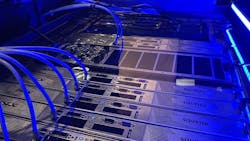Scott Noteboom envisions a future filled with autonomous data centers, which could look very different from the data halls you see today.
“It’s time for version 2 of the data center, which is an environment optimized for machines,” said Noteboom, a veteran innovator in data center design. “We’ve been focused on how to most efficiently design a data center from a human perspective. What do servers look like in a machine-optimized environment?”
Noteboom believes liquid cooling is a key component of the data center of the future. That’s why he has joined immersion cooling startup Submer Technologies as Chief Technology Officer.
The timing of the move commands the industry’s attention, as Noteboom has been a savvy interpreter of data center trends, focusing on extreme energy efficiency in leadership positions at Yahoo and Apple, and shifting to machine learning as a founder at machine learning startup LitBit.
“The most fulfilling work of my career is helping to lead meaningful efficiency improvements in the world’s data center infrastructure,” said Noteboom. “Our progress as an industry truly makes a difference for the world. With growing demands for high performance computing in hyperscale cloud and edge locations, I believe Submer’s hyper-efficient autonomous infrastructure platform is the future and I’m excited to be a part of it.”
At Data Center Frontier we’ve been tracking rack density and liquid cooling adoption for years as part of our focus on new technologies and how they may transform the data center. Some cooling specialists report growing demand, and are investing in additional production capacity. But others say demand for liquid cooling from the data center sector remains “lumpy.” Noteboom’s decision to join Submer is an interesting data point to add to this discussion.
Submer was founded in 2015, and cools servers by immersing them in dielectric fluid, an approach that can manage extreme power density and also offers potential economic benefits by allowing data centers to operate servers without a raised floor, computer room air conditioning (CRAC) units or chillers.
The company says its design can cool compute densities exceeding 100 kW per rack footprint. Servers are inserted vertically into dielectric fluid in Submer’s enclosures. Submer says its SmartPodX Immersion Cooling System also delivers extreme energy efficiency, with a PUE (Power Usage Effectiveness, a key data center energy efficiency metric) of 1.03.
The company’s joint headquarters are split between Barcelona, Spain and Ashburn, Virginia.
Gaining Traction in HPC and Beyond
Noteboom joins Submer as a growing number of data centers are grappling with rising power densities, often because artificial intelligence workloads demand more powerful hardware. Noteboom will help drive strategic innovation across Submer’s immersion cooling offerings and work on developing an autonomous infrastructure platform.
Server immersion has typically been the domain of high-performance computing (HPC) and bitcoin mining operations, but the growth of AI workloads powered by GPUs and other specialized chips has pushed rack densities higher in data centers operated by hyperscalers.
A technician performing maintenance on servers in a a Submer immersion cooling enclosure. (Photo: Submer)
“The first adopters are HPC,” said Daniel Pope, the co-founder and CEO of Submer. “They’re the Formula One of computing.”
But Submer is gaining traction in other verticals as well. Pope says Submer has deployed its technology in 45 sites around the globe in the past 18 months, including the CERN particle physics lab that is home to the Large Hadron Collider. It recently deployed its immersion technology at the EU Joint Research Center in Italy, which supports cybersecurity research for the European Commission.
Submer’s customers also include telecom firms in Vietnam and the United Arab Emirates, and the company has installed pilot systems with multi-tenant colocation providers Digital Realty and Evocative.
“We’re really trying to turn the market toward immersion cooling,” said Pope. “We definitely want to take this mainstream, from enterprise right on up to the hyperscalers.”
There are a number of existing vendors offering single-phase immersion tanks with dielectric fluid. Submer says its innovation is focused on its cooling distribution unit (CDU) and the fluid itself, which is proprietary to Submer.
Direct competitors in single-phase immersion include Asperitas and GRC (Green Revolution), which joined forces this week to create an Immersion Cooling FAQ web site to “dispel a number of misconceptions that have been circulating throughout the data center industry” about the technology.
Pope agrees that education is critical to immersion cooling adoption, but says that Submer sees growing signs of market readiness.
“With the hardware OEMs, the picture has completely changed in the last 8 to 12 months,” said Pope. “The well-known OEMs are realizing that customers are interested (in immersion cooling). We can see them all turning around, not just on servers, but GPUs and networking.We think our efforts in education have paid off in a very interesting way.
“This first phase has been about making it easy to adopt the technology,” he added. “It’s easiest to work with the form factors and environments that people are familiar with. Immersion cooling is already solving a lot of challenges in the industry. Scott coming on board confirms that we want to accelerate this technology to the market in a very aggressive way.”
A Vision for Autonomous Data Centers
Noteboom is impressed with Submer’s current technology, and has high hopes for how it can evolve as a platform for new data center designs.
“The forward-thinking mindset of Submer is really important,” said Noteboom. “It’s about so much more than immersion cooling.
“With HPC and edge computing, there is an expectation that we’re nearing an inflection point for change,” he said. “We’ve begun to hit the wall in terms of machines working well in a human environment. How do we connect the dots between the human environment and the machine environment?”
Scott Noteboom has joined Submer as Chief Technology Officer. (Photo: Submer)
Noteboom believes the answer will be software and robots. The first step is to develop software that can manage data center operations (a key theme at LitBit) and optimize on the fly.
“What does the API look like between physical systems and virtual systems?” Noteboom wonders. “What kind of logic can you put in your software to to optimize servers within a cluster? Virtual resource schedulers can manage more data center functions when they are automated. This makes the potential of robotics even more compelling. It’s how you manage the connection between the immersion environment and the rest of the data center.”
Noteboom started his CTO position at Submer last week, and has just begun working on a roadmap for the transition he envisions to a machine-optimized data center. Even in his early days on the job, Notebook said he expects to apply lessons from other industries – a practice that has been a theme in his career:
- At LitBit, Noteboom adopted monitoring methodologies from medical laboratories, which used microphones and sensors to detect audio signals from mice in giant vivariums. These concepts were put to work in AI monitoring systems that used sound patterns to detect anomalies in generator operations.
- At Yahoo, Noteboom studied the food industry to pioneer the “chicken coop” design in the company’s data centers in Lockport, N.Y. and Quincy, Wash. , which served as giant air handlers that allowed heat to escape through the roof.
In thinking about creating autonomous data centers, “there’s a lot to be learned from the warehouse industry,” said Noteboom. “A lot of innovation has occurred in the warehouse space. At the end of the day, maybe data centers look more like an automated warehouse.”
Thinking Inside the Box
Noteboom compared today’s huge data centers to “boutique” designs, and believes that will change as the industry becomes more industrialized.
“I think of some of the most beautiful data halls I’ve seen,” said Noteboom. “Then I envision a box that takes up 10 percent of that data hall, and doesn’t require a UPS or cooling infrastructure, but still delivers the same capacity. It’s easy to look forward and see big, square, high-power buildings. And maybe the data center of the future doesn’t take 18 months to build.”
Noteboom began running data centers in 2000 at AboveNet, one of the major colocation players during the dot-com boom and bust. He would go on to lead the data center team at Yahoo, and in 2011 he moved to Apple as Head of Infrastructure Strategy, Design, and Development. Noteboom then led a small team in launching LitBit in 2013.
LitBit was founded to create a software platform for the Internet of Things, but soon shifted its focus to harness artificial intelligence to automate data center management. The company’s AI monitoring technology was used by ROOT Data Center (now part of Compass), and CBRE Data Centre Solutions.
Noteboom declined comment on the current status of LitBit and its technology, saying there might be more details to come. For now, he said the startup had challenges with the timing of its development, and also had customers and investors in Asia during a period of shifting policies on trade.
In Submer, Noteboom believe he has found an ideal platform to explore the next phase of the evolution of the data center. The Submer team is excited about the possibilities.
“As soon as I met Scott, I knew he was the perfect fit,” said Pope. “Bringing more compute power in smaller footprints with dramatically reduced power consumption is more than good business strategy. It’s a practical, economic, and environmental imperative. Scott gets it. No one understands the challenges and possibilities better, and there’s no one better to help us drive that innovation forward.”
About the Author



